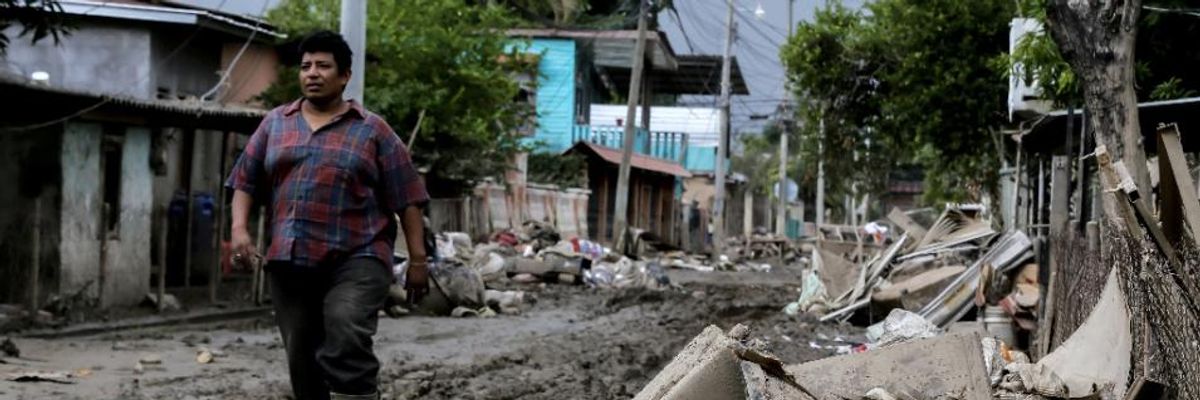Less than two weeks after the Category 4 Hurricane Eta devastated communities in multiple Central American countries, Hurricane Iota was declared a Category 5 storm on Monday as it barreled toward the same region--prompting meteorologists, scientists, climate campaigners, and local leaders to reiterate the necessity of addressing human-caused global heating.
The U.S. National Hurricane Center (NHC) said at 7:00 pm that "the western eyewall of Category 5 Iota is over Nicaragua," warning that "catastrophic winds, life-threatening storm surge, and torrential rainfall [are] occurring in Central America." Maximum sustained winds are near 160 miles per hour with higher gusts, and "little change in strength is expected until landfall."
Matthew Cappucci, a meteorologist with the Washington Post's "Capital Weather Gang," pointed out even before that NHC advisory that "the storm is the strongest Atlantic hurricane ever to develop this late in the season." Following warnings from experts earlier this year, 2020's "fossil-fueled" season has shattered multiple records.
Extreme weather experts and climate activists took to social media on Monday not only to note some of those records but also to demand ambitious and immediate action to dramatically cut down greenhouse gas emissions--especially by rich countries and corporate polluters that disproportionately contribute to the global crisis.
"The Caribbean coast of Nicaragua and Honduras is at the front lines of climate change, a primarily Indigenous region known as the Miskito Coast where people have struggled for autonomy for centuries," meteorologist and writer Eric Holthaus detailed Monday in The Phoenix, his newsletter about the climate emergency. "The region's major city, Bilwi (known in Spanish as Puerto Cabezas, pop. 70,000), will take a direct hit from both hurricanes."
"It's unheard of for two hurricanes so strong to strike the same place so close together, anywhere in the Atlantic basin, at any time of the year--let alone Central America in mid-November," Holthaus noted. "For a few days, Eta was the strongest hurricane of this record-breaking 2020 hurricane season, until Iota. Iota is now one of the strongest and most rapidly-intensifying hurricanes in recorded history, stronger than Hurricane Katrina's 2005 landfall in New Orleans."
Scientists studying hurricanes have, in recent years, highlighted connections between both the process of rapid intensification and slow-moving storms that drop more rain on concentrated areas to the climate crisis. Additionally, as InsideClimate News reported Sunday, hurricane research published in Nature last week shows that "because of global warming, their destructive power persists longer after reaching land, increasing risks to communities farther inland that may be unprepared for devastating winds and flooding."
Climatologist Michael Mann, who directs the Penn State Earth System Science Center and was not involved with the study, commented on the findings to the news outlet.
"Since flooding is the major cause of death and destruction from landfalling tropical storms, this study suggests the potential for even greater risk than has been established in past studies," Mann said. "It's a simple idea, but it requires quite a bit of work to establish that this is really happening. And that's what the authors, in my view, have done here."
In a series of tweets about Iota--the 30th named storm of this historic hurricane season--Mann reiterated early Monday that climate change "is super-charging hurricanes" and "anyone who tells you different is selling something--most likely, fossil fuels."
Holthaus, in his newsletter Monday, shared a private message he received on Twitter from Eric Blake, a senior hurricane specialist at the NHC.
"Today was the kind of day with that pit in your stomach feeling," Blake said. "There's a helpless feeling really. I've had that feeling way too often this season."
After noting that "the people of Nicaragua and Honduras did almost nothing to cause climate change, yet they are bearing terrifying floods from a record-breaking hurricane," Holthaus explained:
In recent years, national governments and powerful industries in Central America have cracked down on dissent and even killed environmental activists in an attempt to further marginalize Indigenous people and steal their land, even as the land is being radically transformed by climate change. In Guatemala, Indigenous people have launched their own hurricane relief efforts, after years of marginalization by their own governments. Since Hurricane Eta, Indigenous people along the Nicaragua coast have resorted to a traditional form of mutual aid called "pana pana," where neighbors give what they have to those in greater need.
A better world is possible, and we must demand it. That starts with securing land rights for Indigenous people.
While Central American governments have faced some criticism related to the climate crisis and Indigenous rights, the New York Timesreported that "the leaders of Honduras and Guatemala called Monday for an increase in international funding to combat the effects of climate change and to aid their recovery efforts amid recent natural disasters."
"Central America is not the producer of this climate change situation," Honduran President Juan Orlando Hernandez said at a news conference. "Instead, we are the most affected."
Pointing to a Sunday report from the Guardian in which scientists tie this year's record-breaking hurricane season to the climate crisis, Greenpeace called for global action in a tweet Monday.
"It's a simple equation: as the global temperature rises storms get bigger, longer, and more frequent. Do we really want to risk seeing more and more deadly hurricanes?" the group said. "We need governments to act on climate RIGHT NOW. Every minute counts."

